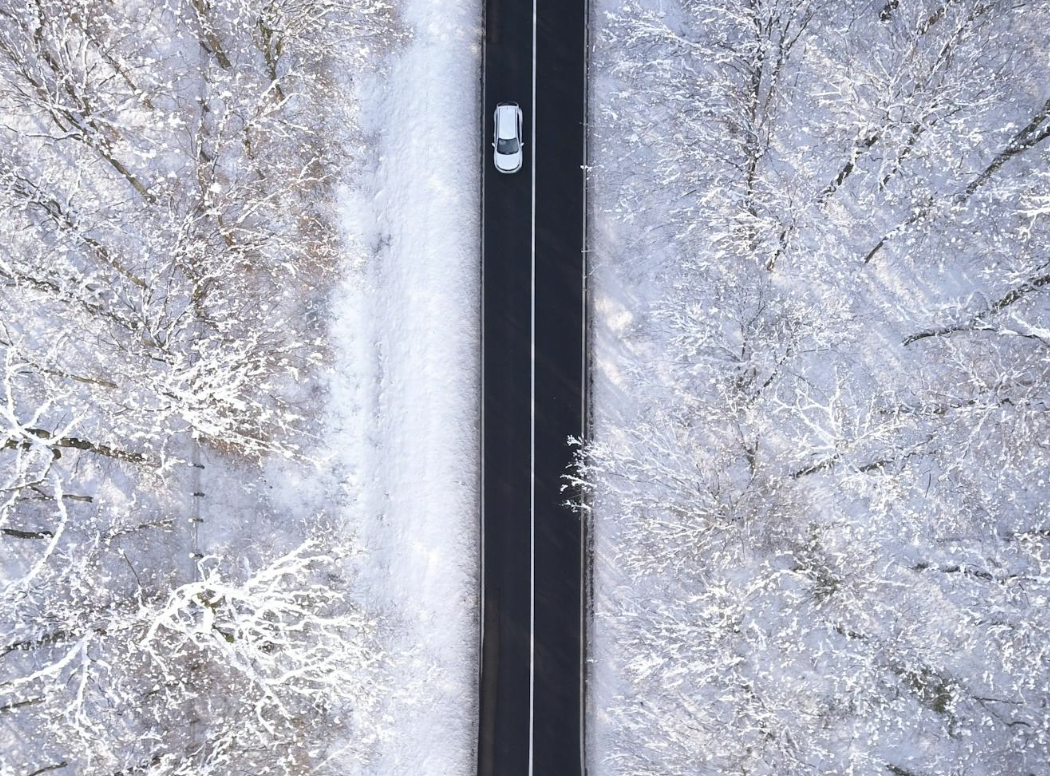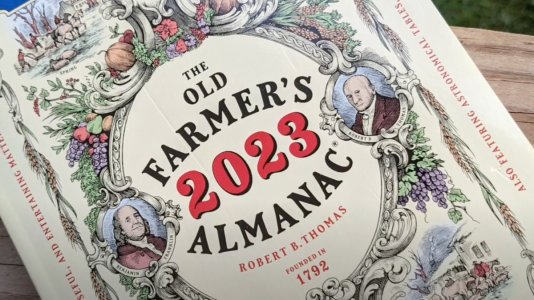
You're scrolling through vacation deals for February, trying to picture yourself on a sunny beach or gliding down snowy slopes. But there's that nagging question: what will the weather actually be like when you get there? Your phone's weather app barely gets next week right, let alone predicting conditions months ahead.
Here's where an unlikely ally comes in—one that's been helping Americans plan ahead since the days of George Washington.
This familiar little yellow booklet, often spotted at grocery store checkouts, might just be the most reliable long-term weather tool you never knew you needed.
A weathered classic with surprising staying power
Published since 1792, The Old Farmer's Almanac claims to be the oldest continuously published periodical in the US.
While your smartphone gets software updates every few months, this publication has been using essentially the same forecasting method for over two centuries—and it's still going strong.
The almanac claims an 80% accuracy rate for its weather predictions.
Last winter's total accuracy rate was 86.1%, above their traditional average.
Not bad for a method that predates the telegraph, let alone satellites and supercomputers!
"Even when we're off, they give us a little more leeway"
Also read: Stay warm this winter without turning up the heat—Walmart’s cozy $8.99 find
The great accuracy debate
Before you start planning your entire winter around almanac predictions, there's a catch worth knowing about.
The Farmers' Almanac's weekly predictions have 52% accuracy, according to a 2010 University of Illinois study—which is basically the same odds as flipping a coin.
But here's the thing— that study looked at very specific weekly forecasts, not the seasonal trends that make almanacs most useful for vacation planning.
Think of it this way: the almanac might not tell you it'll rain on Tuesday, but it can give you a decent idea of whether this winter will be unusually cold in Colorado or surprisingly mild in Florida.
What the almanacs are saying about winter 2025-2026
The two major almanacs are painting different pictures for the coming winter.
The Farmer's Almanac predicts a "very cold, snowy" winter for much of the northern United States, including Colorado, Kansas, Nebraska, and the northern plains and Midwest.
Meanwhile, The Old Farmer's Almanac is forecasting an upcoming winter that is "mostly mild—with pockets of wild" across the continental US.
Temperatures are expected to be "near normal to slightly milder across much of the US," but colder than average in the Appalachians, Southeast, Florida, and the Ohio Valley.
What's the difference between the two almanacs?
While both trace their roots to the early 1800s, they use different forecasting methods and often disagree.
The Old Farmer's Almanac (1792) focuses more on solar activity, while the Farmer's Almanac (1818) emphasizes lunar cycles and planetary positions.
Both claim high accuracy rates, but independent studies suggest their long-term seasonal trends are more reliable than specific weekly forecasts.
Also read:15 Winter vacation spots seniors will love—from cozy retreats to sunny escapes
How to use almanac predictions for your winter travel planning
Rather than betting your entire vacation on one forecast, treat almanac predictions as one piece of a larger puzzle.
If you're considering a ski trip to Colorado and both almanacs suggest heavy snow, that's encouraging.
If you're dreading cold weather and thinking about escaping to Arizona, almanac predictions of a mild winter might influence your timing.
The science behind the folklore
The almanacs employ three scientific disciplines: solar science, climatology, and meteorology.
They predict weather trends by comparing solar patterns and historical weather conditions with current solar activity.
It's not just guesswork—there's real meteorological reasoning behind those predictions, even if the exact formulas remain closely guarded secrets.
They're looking at "normals" or "averages" over decades, not just how the weather compares to last year.
For the 2025–2026 winter season, their forecasts are based on the latest period, 1991 through 2020.

Also read: Discover How Drinking More Water This Winter Can Transform Your Health - You Might Be Missing Out!
Modern alternatives that complement the almanac approach
You don't have to choose between old-school wisdom and modern technology.
The National Weather Service's Climate Prediction Center offers seasonal outlooks that extend three months ahead, using sophisticated computer models and oceanic data.
These forecasts focus on probability—telling you there's a 60% chance of above-normal temperatures, for instance.
For online research, try searching for your destination plus terms like "average winter temperature" or "historical snowfall data."
Websites like Weather Underground and TimeandDate.com offer detailed historical weather information that can give you a baseline for what to expect.
Also read: Mom's 6 creative winter solutions from Dollar Tree—stay warm for under $9!
The real value for senior travelers
Here's where almanacs shine for mature travelers: they help you avoid the biggest weather surprises.
Nobody wants to arrive in Vermont expecting mild skiing weather only to find the slopes closed due to lack of snow. Or book a Florida beach house during an unexpected cold snap.
Did you know?
Did you know?
The Old Farmer's Almanac correctly predicted the unusual July snow during 1816's "Year Without a Summer," caused by the eruption of Mt. Tambora. Their prediction of "rain, hail, and snow" for that July seemed impossible at the time but proved remarkably accurate.
Making the most of your $10 investment
Both major almanacs cost around $10—less than a single night's hotel parking in most cities.
For that modest investment, you get not just weather predictions but also sunrise and sunset times, moon phases, and tide charts that can enhance your travel experience.
The real charm lies in using almanacs as a starting point for conversations about your destination.
Local residents often have strong opinions about almanac accuracy in their area, and asking about it can lead to valuable insider tips about the best times to visit.
Also read: Transform your winter driving with this unexpected shaving cream trick!
When almanacs work best (and when they don't)
Almanac predictions work best for broad seasonal trends—whether winter will be unusually harsh or mild, if summer will be particularly dry, or when the first frost might arrive.
They're less reliable for specific dates or short-term conditions.
For vacation planning, this translates to being most useful when you have flexibility in your travel dates.
If you're planning a winter trip sometime between January and March, almanac predictions can help you choose the best month.
If you must travel during the week of February 14, you'll need more precise forecasting tools as your departure approaches.
Smart almanac use for winter travel planning
- Use seasonal predictions to choose general time periods, not specific dates
- Compare both major almanacs for a broader perspective
- Combine almanac forecasts with modern seasonal outlooks from NOAA
- Focus on temperature and precipitation trends, not daily specifics
- Remember that 80% accuracy still means being wrong 1 in 5 times
- Use historical weather data to understand what "normal" looks like for your destination
Also read: Drivers beware: The winter car problem you didn’t know you had—solved!
The bottom line on almanac accuracy
Nobody—not the almanacs, not NOAA, not your local meteorologist—can tell you with certainty whether it will be snowing on February 15 in Denver.
What the almanacs can offer is a centuries-tested method for understanding seasonal patterns, backed by surprisingly solid track records.
For the cost of a lunch out, you get access to the same seasonal insights that have helped Americans plan ahead since before the Civil War.
In our age of information overload, there's something refreshingly straightforward about a simple yellow book that cuts through the noise to tell you whether this winter might be a good time to head south—or stock up on firewood.
Whether you trust them completely or treat them as just one voice in the forecasting chorus, almanacs offer something our smartphones can't: the accumulated wisdom of more than two centuries of American weather observation.
For winter travel planning, that long view might be exactly what you need!
Read next:
- Experts reveal their top secrets to keeping your family cozy and safe this winter–don’t miss out!
- Winter wellness: The ultimate tips to stay healthy!
- Neurologist warns this common household item could be a winter hazard–here's what you need to know!
What's your experience with long-range weather planning for travel? Have you ever used an almanac to help decide when or where to take a winter vacation? Share your stories and tips in the comments below.
Original Article
https://www.explore.com/1977203/far...hlid=9da1d21db95e0c3be183838b2f6176674922f165
Old Farmer’s Almanac Predicts US Weather for Winter 2025 - Newsweek
Cited text: Published since 1792, The Old Farmer's Almanac claims to be the oldest continuously published periodical in the U.S.
Excerpt: Published since 1792, The Old Farmer's Almanac claims to be the oldest continuously published periodical in the U.S.
https://www.newsweek.com/old-farmers-almanac-prediction-us-weather-winter-2025-2026-2117838
How Accurate is The Old Farmer’s Almanac’s Weather Forecast? | Almanac.com
Cited text: · On average, The Old Farmer’s Almanac weather predictions are 80% accurate.
Excerpt: The almanac claims an 80% accuracy rate for its weather predictions
https://www.almanac.com/how-accurate-old-farmers-almanacs-weather-forecast
The 'Old Farmer’s Almanac' Predicts a Warmer Fall for 2025
Cited text: But the Old Farmer's Almanac claims an 80% accuracy rate and they've been around since 1792 so they know a thing or two to say the least.
Excerpt: The almanac claims an 80% accuracy rate for its weather predictions
https://www.thepioneerwoman.com/new...armers-almanac-fall-weather-predictions-2025/
Old Farmer's Almanac Predicts US Weather for Summer 2025 - Newsweek
Cited text: Its seasonal guidance is followed closely by many due to its historic accuracy rate, which the Almanac itself pegs around 80 percent.
Excerpt: The almanac claims an 80% accuracy rate for its weather predictions
https://www.newsweek.com/old-farmers-almanac-weather-predictions-summer-2070659
How Accurate is The Old Farmer’s Almanac’s Weather Forecast? | Almanac.com
Cited text: This makes last winter’s total accuracy rate 86.1%, above our traditional average rate of 80%.
Excerpt: last winter's total accuracy rate was 86.1%, above their traditional average
https://www.almanac.com/how-accurate-old-farmers-almanacs-weather-forecast
Experts weigh in on accuracy of Farmers' Almanac's winter predictions
Cited text: The perception with the public is that is very accurate." The Farmers' Almanac's weekly predictions have 52% accuracy, according to a 2...
Excerpt: The Farmers' Almanac's weekly predictions have 52% accuracy, according to a 2010 University of Illinois study, which is basically the same odds as flipping a coin.
https://www.9news.com/article/weath...uracy/73-23b95398-2266-4b49-a3bf-f9892b65096f
Experts weigh in on accuracy of Farmers' Almanac's winter predictions
Cited text: The Farmers' Almanac's weekly predictions have 52% accuracy, according to a 2010 University of Illinois study, which is basically the same odds as fli...
Excerpt: The Farmers' Almanac's weekly predictions have 52% accuracy, according to a 2010 University of Illinois study, which is basically the same odds as flipping a coin.
https://www.9news.com/article/weath...uracy/73-23b95398-2266-4b49-a3bf-f9892b65096f
Experts weigh in on accuracy of Farmers' Almanac's winter predictions
Cited text: It predicts a "very cold, snowy" winter for much of the northern United States, including Colorado, Kansas, Nebraska and the northern plains and Midwe...
Excerpt: The Farmer's Almanac predicts a "very cold, snowy" winter for much of the northern United States, including Colorado, Kansas, Nebraska and the northern plains and Midwest.
https://www.9news.com/article/weath...uracy/73-23b95398-2266-4b49-a3bf-f9892b65096f
Winter Weather Forecast 2025 - 2026 - Farmers' Almanac
Cited text: Farmers’ Almanac 2025 – 2026 winter forecast calls for a season of dramatic swings and widespread wintry weather.
Excerpt: The Farmer's Almanac predicts a "very cold, snowy" winter for much of the northern United States, including Colorado, Kansas, Nebraska and the northern plains and Midwest.
https://www.farmersalmanac.com/extended-forecast
Old Farmer’s Almanac Predicts US Weather for Winter 2025 - Newsweek
Cited text: The Old Farmer's Almanac is forecasting an upcoming winter that is "mostly mild—with pockets of wild" across the continental U.S., predicting near‑nor...
Excerpt: The Old Farmer's Almanac is forecasting an upcoming winter that is "mostly mild—with pockets of wild" across the continental U.S.
https://www.newsweek.com/old-farmers-almanac-prediction-us-weather-winter-2025-2026-2117838
Old Farmer’s Almanac Predicts US Weather for Winter 2025 - Newsweek
Cited text: Temperatures are expected to be "near normal to slightly milder across much of the U.S.," but colder than average in the Appalachians, Southeast, Flor...
Excerpt: Temperatures are expected to be "near normal to slightly milder across much of the U.S.," but colder than average in the Appalachians, Southeast, Florida, and the Ohio Valley
https://www.newsweek.com/old-farmers-almanac-prediction-us-weather-winter-2025-2026-2117838
Winter Weather Forecast 2025–2026 for the U.S. | The Old Farmer’s Almanac
Cited text: We employ three scientific disciplines: Solar science, the study of sunspots (magnetic storms on the Sun’s surface) and other solar activity; Climatol...
Excerpt: The almanacs employ three scientific disciplines: solar science, climatology, and meteorology
https://www.almanac.com/winter-extended-forecast-farmers-almanac
Old Farmer’s Almanac Predicts US Weather for Winter 2025 - Newsweek
Cited text: The publication explains that its forecasts are developed using insights from three scientific disciplines: solar science, climatology, and meteorolog...
Excerpt: The almanacs employ three scientific disciplines: solar science, climatology, and meteorology
https://www.newsweek.com/old-farmers-almanac-prediction-us-weather-winter-2025-2026-2117838
Winter Weather Forecast 2025–2026 for the U.S. | The Old Farmer’s Almanac
Cited text: We predict weather trends and events by comparing solar patterns and historical weather conditions with current solar activity.
Excerpt: They predict weather trends by comparing solar patterns and historical weather conditions with current solar activity.
https://www.almanac.com/winter-extended-forecast-farmers-almanac
Winter Weather Forecast 2025–2026 for the U.S. | The Old Farmer’s Almanac
Cited text: We’re looking at “normals” or “averages” over decades, not just how the weather compares to last year. For the 2025-2026 winter season, our forecasts ...
Excerpt: They're looking at "normals" or "averages" over decades, not just how the weather compares to last year.
https://www.almanac.com/winter-extended-forecast-farmers-almanac






